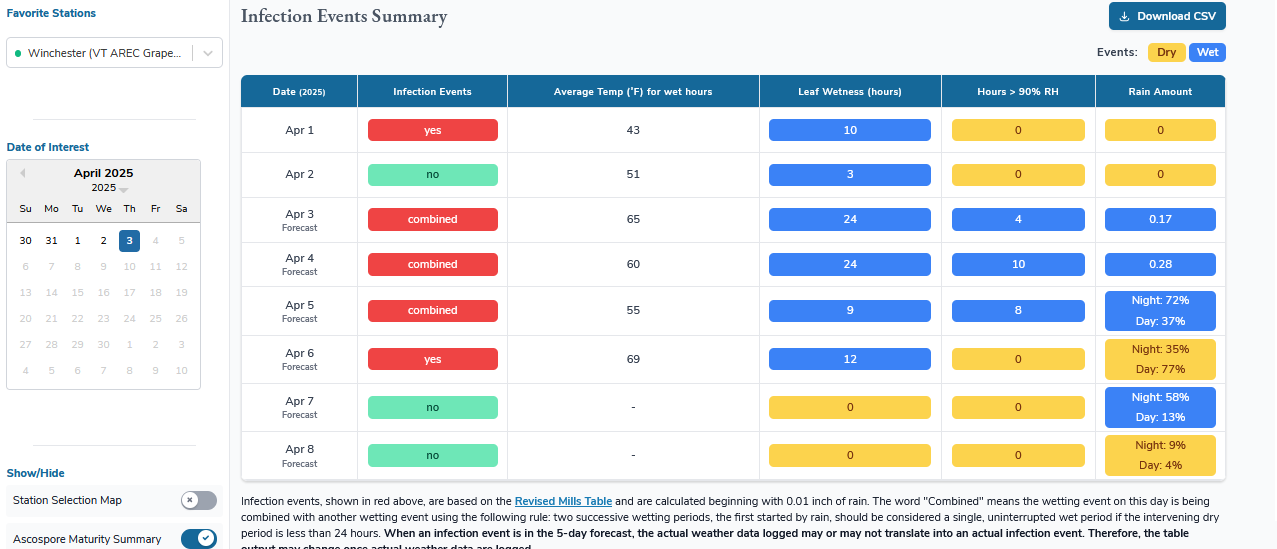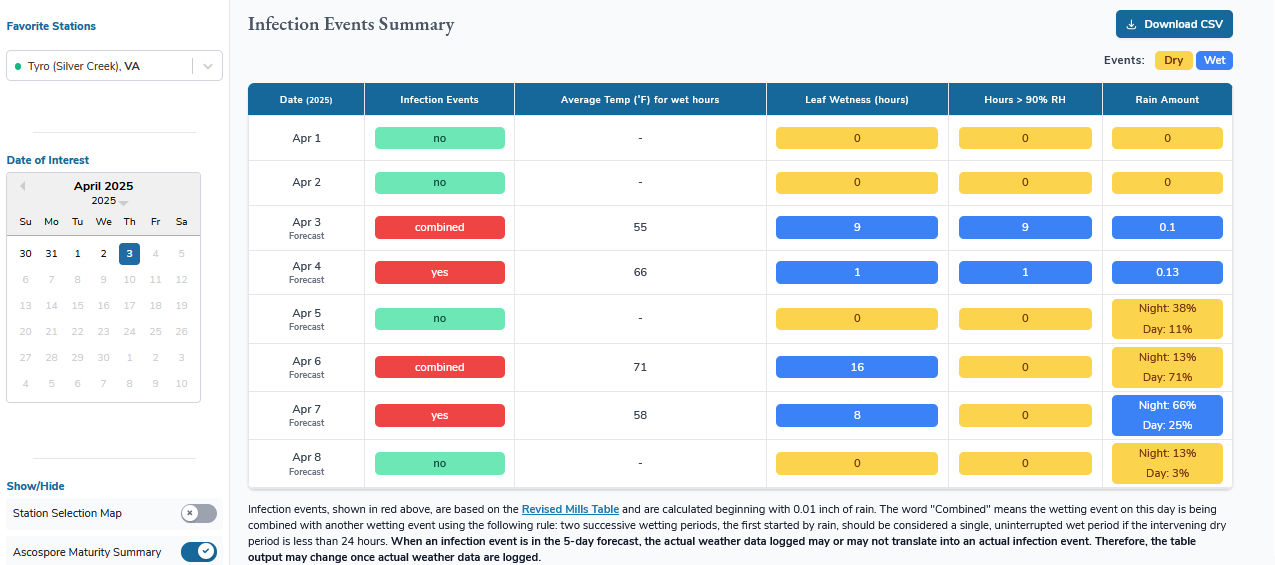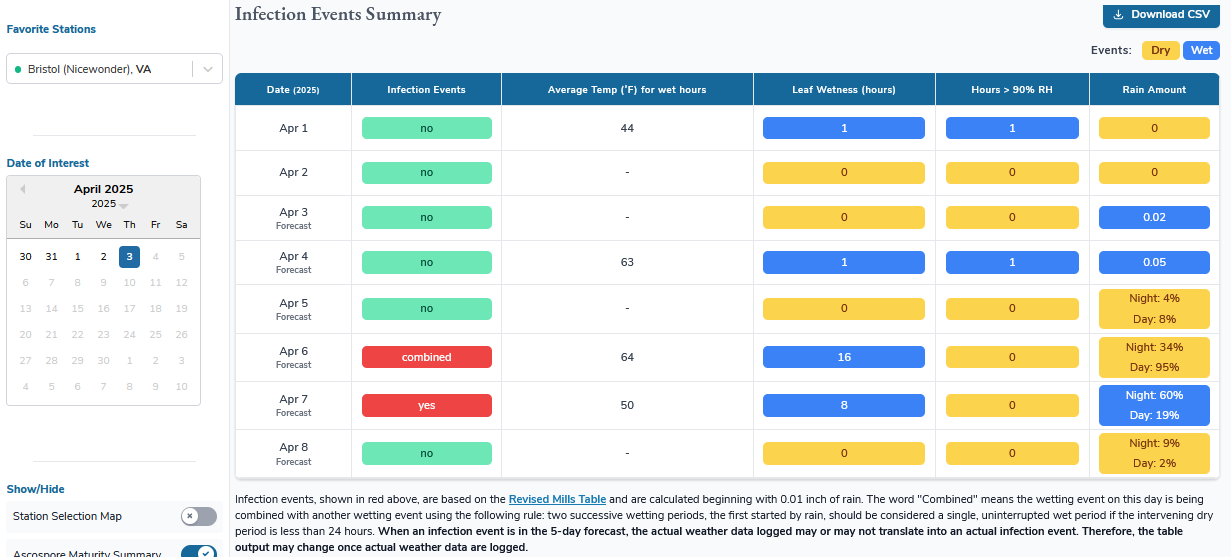Major Fire Blight and Apple Scab Infections Predicted With Rains From 3 – 6 April in All Virginia, Varying Slightly Depending on Location: Look at Your Disease Models
1. Heat and rain predicted from 3- 6 April will lead to major fire blight infections in all Virginia:
The below outputs from the NEWA EIP model using NWS forecast show that we are expecting a series wetting events on 3rd, 4th all the way until 6th April, which will lead to fire blight infection on all pome fruit in bloom, if the current weather forecast becomes reality on those days. As per the NEWA’s EIP model, we start to worry when we reach the Infection potential EIP value of ≥ 100 but keep in mind that ALL the conditions need to fulfill at the same time for a fire blight infection to occur and the box with EIP to turn in dark red color indicating “Infection”:
1. Open(ing) young flowers,
2. Accumulated heat units for fire blight bacterial inoculum to reach the necessary cell numbers (EIP 100 and above),
3. A wetting event (dew, rain, spray water) to wash bacteria down into the flower base (nectar glands),
4. Average temperature above 60F.
The key is, on 3, 4 and 6 April in Bristol VA and on 4th to 6th April in all other locations in Virginia, the weather conditions are predicted to favor fire blight infections and that is why the box with EIP turned into dark red indicating infection (see print screens below).
OPTION 1: If you have a large acreage and you want to be on a safe side thinking you will get the rains on 3rd to 6th April, I would recommend you to cover before the predicted wetting events any apple and pear trees in bloom with streptomycin: Harbor, or Agrimycin 17, or Fire Wall 17 WP at 1 to 1.5 lb per acre (16 – 24 oz/A) plus LI 700 at a penetrating rate or Regulaid. Based on the Regulaid label, rate which ranges from 1 to 4 pints per 100 gallons of spray mixture, I would use a 2 pints penetrating rate. Keep in mind that FireWall has changed its formulation to FireWall 50WP and the rate to use this higher concentrated material is 8 – 16 oz./Acre. If you still have FireWall 17 WP in your shed use the rate of 16 -24 oz./Acre as it is less concentrated.
OPTION 2: If you have a smaller acreage farm, the other somewhat risky option is to wait and see will you get the wetting event or not on 3-6 April. So, whether the infection will occur or not will depend on whether rain will occur or during the days with EIP value 100 or above (keep an eye on the EIP model daily so you know will the rain prediction change or not). Then, if rain occurs, protect any blooming apple cultivars with streptomycin in mix with Regulaid or LI700 using rates above by applying it up to 24 h after the infection rain event (kick-back mode of application). In case you will use LI700 instead of Regulaid, use a penetrating action rate for LI700. If wetting doesn’t occur, infection will not occur, unless you provide water with a fungicide spray application during 3-6 April which can and will trigger the infection. If you want to be on a cheaper side, Option 2 is a possibility you should consider.
*Note: In terms of timing your spray, I would trust more the EIP model in NEWA than the Cougarblight model. Keep in mind that changing the “Orchard Blight History” above the model will change how the risks for infection change in Cougarblight.
WARNING: If you used captan recently, which would not be my choice, DO NOT add Regulaid or LI700 to streptomycin for this bloom spray against fire blight. You could and should add fungicides against rust, powdery mildew or scab to this spray to make it more economical, and a good choice would be mancozeb (3 lb/A) + either Fontelis, Sercadis, Miravis or Excalia. However, if yo already see orange galls from rust in Southern and Central Virginia Inspire Super, Rhyme, Procure or Rally would be a better choice as a tank mix partner to mancozeb. Previous data indicate that using Regulaid and other surfactants in repeated sprays (if one needs 2 or 3 applications of strep during bloom) will lead to significant amounts of leaf yellowing. Hence we suggest using Regulaid or LI 700 ONLY with the first streptomycin spray application and then applying strep without the adjuvat in any subsequent sprays. Do NOT use Regulaid or LI700 with any sprays that contain thinning materials. Hence, streptomycin included with a petal fall spray should NEVER be mixed with Regulaid or LI 700. Regulaid should NEVER be combined with captan, and other adjuvants that are sometimes used with captan are generally applied at rates that will not provide the penetration effects that one gets with Regulaid. Thus, growers with a major fire blight threat this week must decide if using captan as a scab fungicide is more important to them than achieving the best possible fire blight protection (which requires a penetrating adjuvant, if it is a first major fire blight spray of the season).
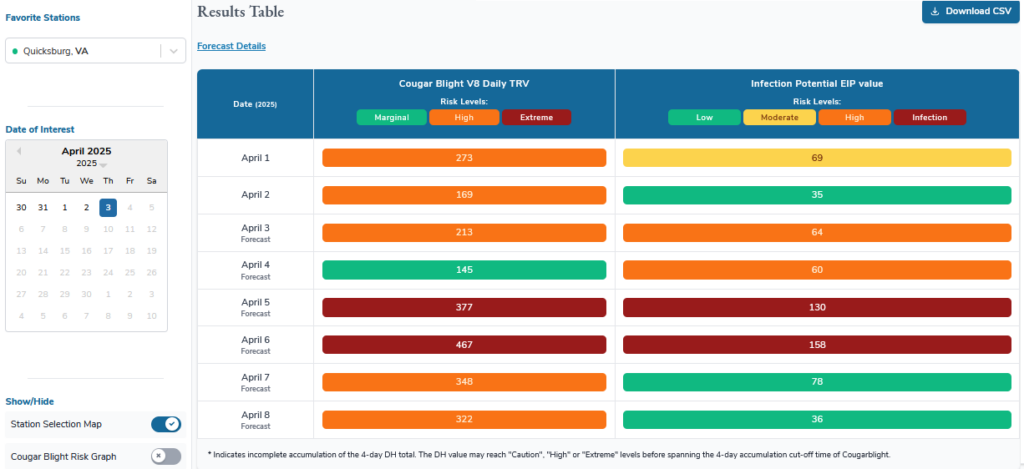
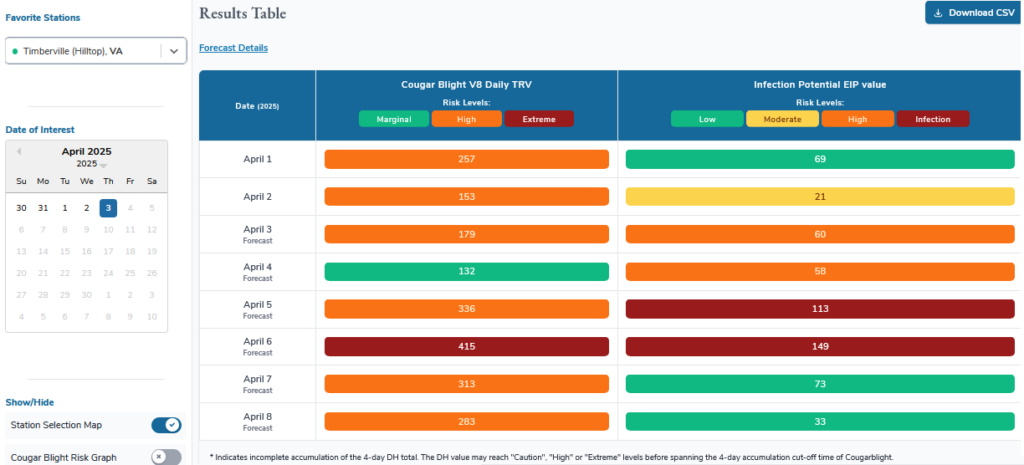
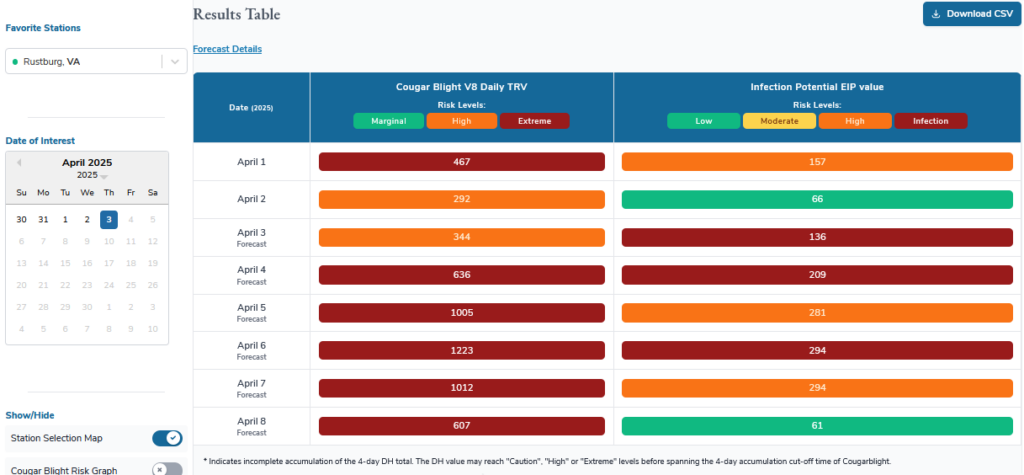
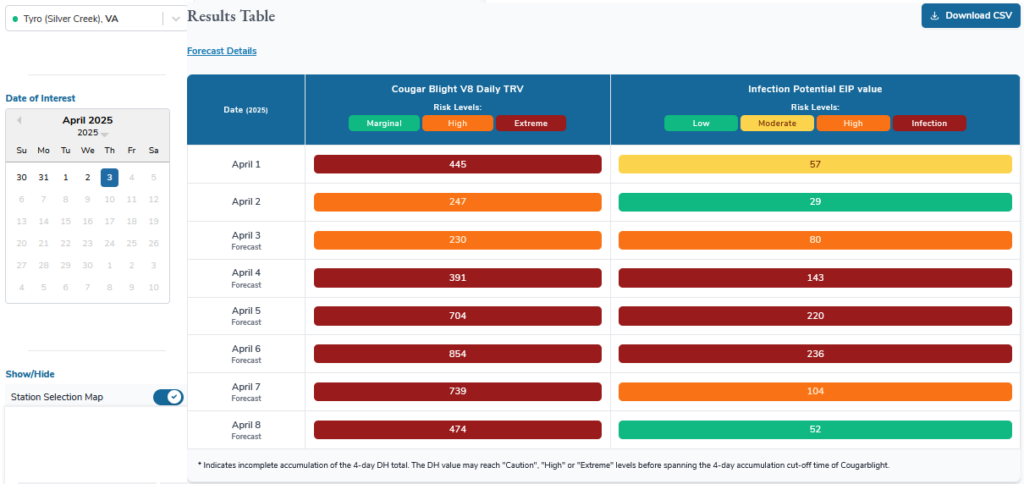

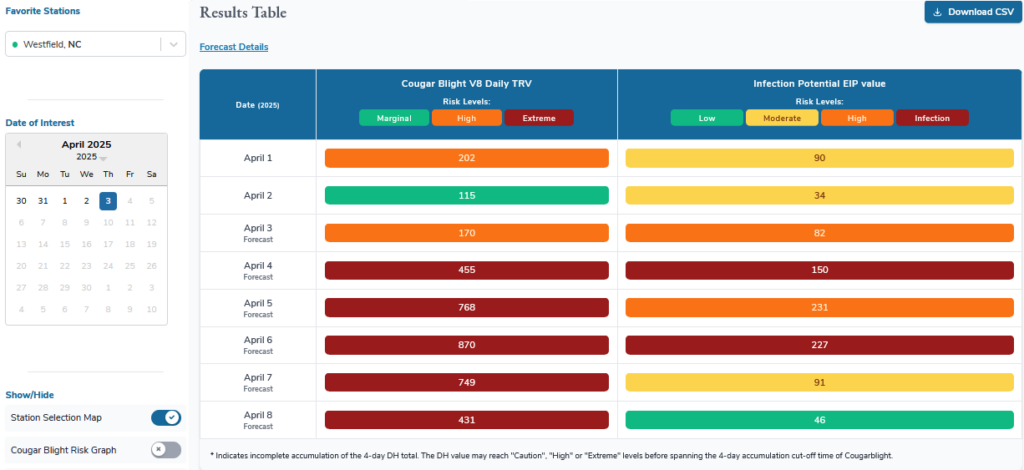
2. If the NWS weather forecast with warm rains predicted for 3-6 April 2025 becomes a reality, we will get the first major scab apple scab infection in all Virginia locations where apples are grown (this will be the second major infection for the southern Virginia: Bristol, Cana, Ararat etc.). These rain events of 3-6 April 2025 warrant a powerful tank mix of a very effective single-site systemic fungicide with a multi-site contact fungicide like mancozeb. Unlike the NEWA scab model which is available for free: https://newa.cornell.edu/apple-scab, RIMpro apple scab model, which is subscription based, allows you to have much more accurate scab infection predictions because of the various aspects of Venturia inaequalis biology incorporated in it in the last 28 years. RIMpro apple scab model actually determines the fate of each separate group of released apple scab ascospores in each hour, during these rain events, and gives you Relative Infection Measure i.e. RIM value of how severe the infections for all these groups of spores will be. Thus, based on predicted infection severity we expect with oncoming rains 3-6 April, I would advise you to definitely apply a single-site systemic fungicide with a multi-site contact fungicide, before these rains.
By using the RIM infection value prediction with plugged in 5 to 7 days weather forecast, you can gauge your response and fungicide cost by applying just a contact fungicide or mixing it with it a systemic fungicide. Just a contact fungicide like mancozeb would be good if the infection is of medium to high strength i.e. from 100-300 RIM Infection Value (Fig. 2 example below for year 2024). However, a combination of Inspire Super or Topguard, Rhyme or Cevya or Miravis (DMI fungicides), or Excalia or Sercadis or Fontelis (SDHI fungicides) plus mancozeb would be necessary if the infection will be high to extreme i.e. 300 RIM Infection Value or higher (Fig. 2 example below for year 2024). The SDHI (Group 7) fungicides I state above will also be very effective also for powdery mildew control. If you use an SDHI fungicide add 10-16 fl oz/100 gal of LI700 to it as this boosts the absorption of SDHI-s into the green tissue and allows longer residual protection throughout the rain events. Keep in mind that SDHI fungicides are not that effective against cedar apple rust (Gymnosporangium juniperi-virginianae) and quince rust (Gymnosporangium clavipes). Most of the apple varieties in Winchester VA are transitioning from Tight Cluster to Pink Bud stage or are already at the Pink Bud stage. In southern Virginia early varieties are approaching to or are at full bloom, and others are at Pink Bud stage.
If you had visible scab symptoms last year in your orchard, you should spray with a fungicide ahead of the early-season predicted scab infection events that are at or above 100 RIM value (e.g. red curved line going to the dashed line of 100 RIM value on the RIMpro graph scale “RIM Infection Value” on the left). RIM value of 100 means that only 1% of seasonal ascospores will be infecting during that wetting event (Fig. 2 below for year 2024).
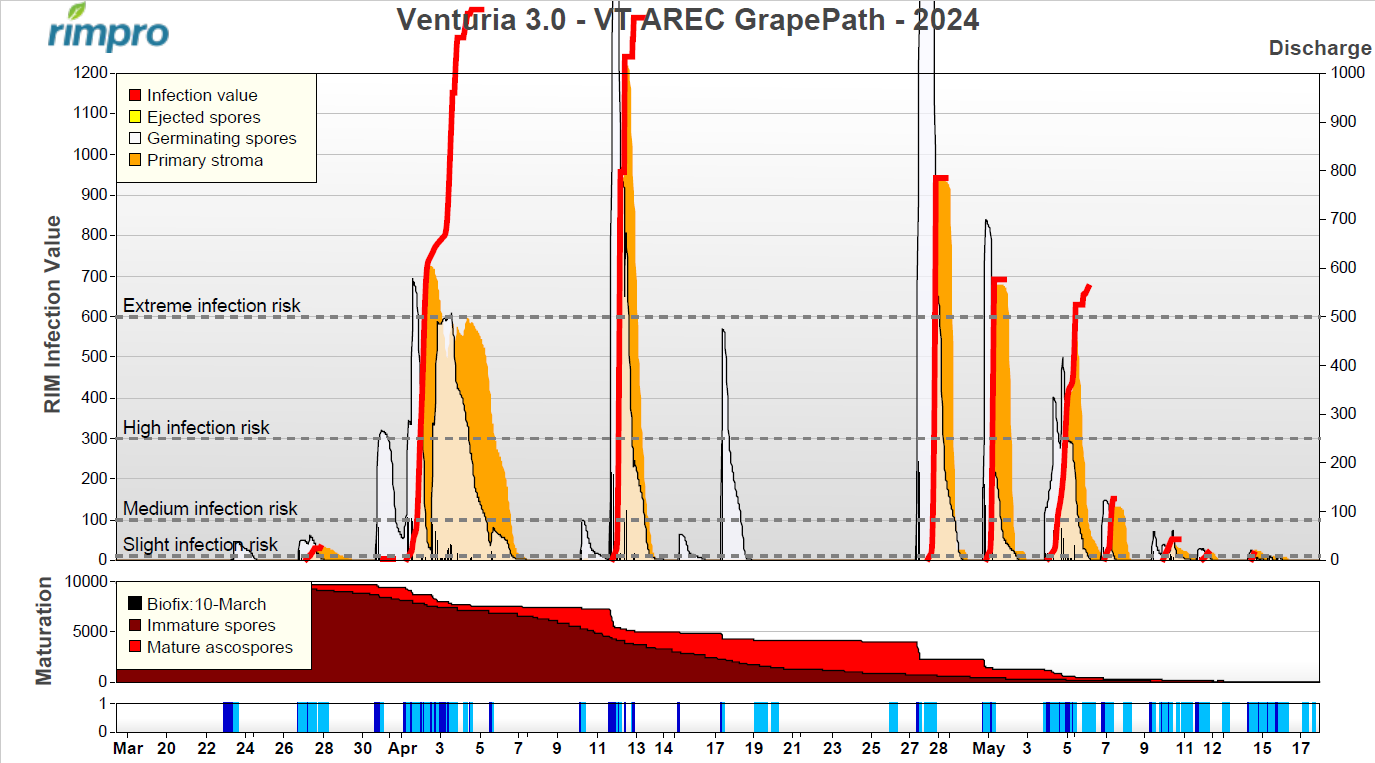
Figure 1. RIMpro apple scab model output showing the actual s infection events in Winchester VA for 2024 apple growing season. The red curved lines are scab infections. Read each red curve’s peak RIM infection value(s) using the vertical Y-axis scale on the left-hand side of the graph labelled “RIM Infection Value”. Peak RIM value i.e. height to which red line goes up to divided by 100 gives you the percentage of the total season’s ascospores that will cause infection for a given wetting event. Used by permission of RIMpro B.V., France.
Right now, if the NWS’s weather forecast stays the same for the actual days of 3-6 April 2025, the RIMpro is calling for an infection of more than 300 RIM value, depending on a location, which is high to extreme infection risk for scab. You can only see the real time 2025 RIMpro scab infection predictions if you subscribe to RIMpro: https://www.rimpro.eu/ (note that the Figure 1 above is from 2024 used as an example, not 2025). Hence, as per RIMpro outputs I see as a coordinator of a nation-wide group of RIMpro subscribed apple growers (over 40), these rain events of 3-6 April 2025 in Virginia are warrantying a top-level choice fungicide spray applications for all apple orchards.
Yes, the best way to apply fungicides is before the predicted infection events. If rust is your major concern – check first do you see galls with spikes coming out of them and being gelatinous and orange on the Juniper trees? If not you do not see fully developed galls on cedars, you do not need to use DMI fungicides just yet (Group 3) and SDHI fungicide, instead, with mancozeb is just fine. If you do see galls fully developed, yes use DMI fungicide instead of SDHI and in mix with mancozeb. However, if scab is your major concern, keep watching at the forecast and the aforementioned scab prediction models to see if the weather forecast and thus scab predictions change as we get closer to 3-6 April 2025. I am warmly recommending you to seriously consider subscribing to RIMpro as this is the BEST apple, pear, and grape grower prediction tool I have seen in years, and which you can use to reduce the number of your seasonal fungicide applications. One subscription to RIMpro and connection fee for one NEWA weather station to RIMpro costs approximately $300 in total. All the largest fruit growers in Virginia are subscribed to RIMpro and I can help you with guiding how to get this process done. If RIMpro is not for you and you will only use NEWA’s apple scab prediction model, major infection events are when there is >15% ascospore discharge predicted. So as you can see below when using NEWA scab model for your weather station of choice, the NEWA scab model agrees with RIMpro that there will be a severe scab infection showing 12 – 21% ascospore discharge predicted with rains on 3-6 April. Sources for below print screens are: NEWA scab model available here: https://newa.cornell.edu/apple-scab
